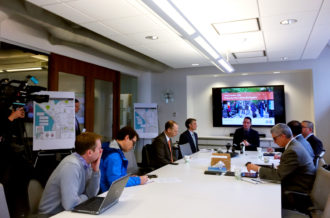
The One Center City partnership released a set of “near-term strategies” for a major redesign of downtown streets Thursday that would increase bus capacity, could increase car capacity, and neither commits to building a connected network of safe bike lanes nor prioritizes safety for people walking (by far the fastest-growing mode downtown).
Aside from the fact that this plan has already delayed the city’s downtown bicycle network for a year, there are some good parts in it. Protected bike lanes are included in most (but not all) options. And there is a joint campaign underway to make up for lost time by expediting a connected network of bike lanes, which Seattle Neighborhood Greenway and Cascade Bicycle Club call a “Basic Bike Network.”
But safety is not measured or prioritized in the One Center City plan, which is a major red flag and cause for concern and scrutiny.
You can learn more in this overview (PDF) and weigh in on the plan via this online open house.
The biggest elements of the plan are focused on how to maintain bus service when all the buses currently operating in the downtown transit tunnel are kicked out, which could happen as early as autumn 2018. One bold idea includes turning 5th Ave into a two-way bus corridor, which could be great for the city and the region. We fully support bold action to maintain bus service and reliability, but won’t be diving too deep into those elements in this post. For more, see posts at Seattle Transit Blog, the Urbanist and the Seattle Times.
The plan update also includes some ideas for the Pike/Pine corridor, which we will explore in a separate post. So stay tuned.
The good
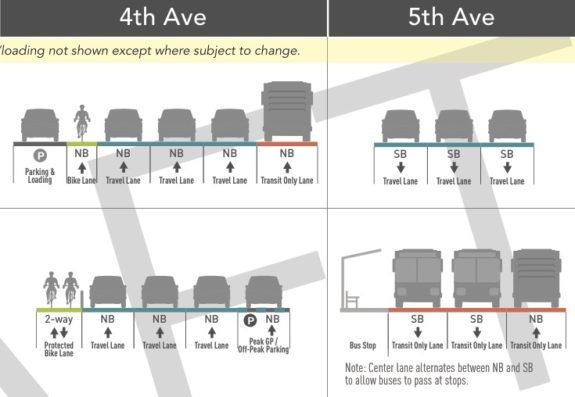
There are some very bold ideas in this plan, including a very strong idea to build a two-way bike lane on 4th Ave and turn 5th Ave into a two-way bus-only street. 6th Ave would also become a two-way street and would handle many of the car trips currently on 5th Ave. 2nd Ave would also become a busier southbound street for people driving.
Here’s a bigger look at Option D, which presents the most clear and ambitious vision for a modern downtown:
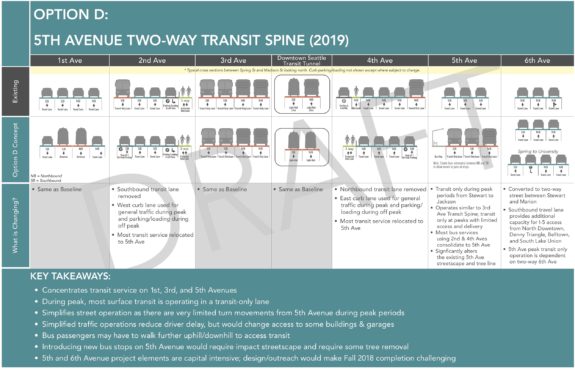 Option B is not quite as bold, but it would be cheaper and more easily delivered on time. And it includes one-way protected bike lanes as a couplet northbound on 4th Ave and southbound on 5th Ave. Many more buses would run on 2nd Ave and 4th Ave, which would get some bus lane improvements. But this plan would result in slower buses compared to Option D.
Option B is not quite as bold, but it would be cheaper and more easily delivered on time. And it includes one-way protected bike lanes as a couplet northbound on 4th Ave and southbound on 5th Ave. Many more buses would run on 2nd Ave and 4th Ave, which would get some bus lane improvements. But this plan would result in slower buses compared to Option D.
The bad
Option A is the “no change” option, which would basically just put buses on their existing no-tunnel re-routes. This option is very bad for bus service and doesn’t include new bike lanes. The status quo isn’t safe and would result in major bus delays.
Option C is a horrible pile of planning garbage. I can’t lie, I flipped out a bit when I first saw it. It’s insulting and troubling that this option is even included, since it actually removes the existing bike lane on 4th Ave without adding any bike lanes to replace it.
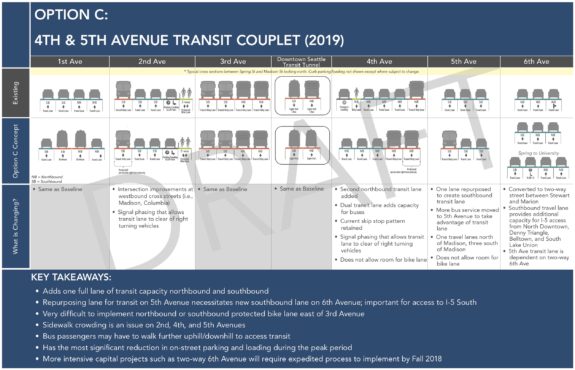 It’s 2017, Mayor Ed Murray’s Vision Zero campaign to end traffic deaths and injuries has been in place for nearly two years, and here is an option to remove even the tiniest little scrap of bike lane Seattle has managed to build downtown in the past two decades.
It’s 2017, Mayor Ed Murray’s Vision Zero campaign to end traffic deaths and injuries has been in place for nearly two years, and here is an option to remove even the tiniest little scrap of bike lane Seattle has managed to build downtown in the past two decades.
OK, now I’m angry again. Deep breaths, Tom, deep breaths…
This option should have been disqualified before it ever saw the light of day. It disregards policies and goals developed over many years and approved by City Council. Its presence raises serious concerns about the process for creating this plan and whether the advisory group’s input — they have stressed safety in their work — is being taken seriously.
Safety is not the plan’s top priority, and that needs to change immediately.
To illustrate the problem, let’s take a look at how the plan is measuring priorities and outcomes. Here’s how it measures bike lane “opportunity”:
 Bike lanes are not a central part of the plan, they are an “opportunity” to be implemented only after “evaluat[ing] performance of general purpose auto and transit.” They aren’t trying to measure how bike lanes would increase the number of people biking or reduce injuries and deaths. They are only measuring how bike lanes would affect cars, which is exactly backwards.
Bike lanes are not a central part of the plan, they are an “opportunity” to be implemented only after “evaluat[ing] performance of general purpose auto and transit.” They aren’t trying to measure how bike lanes would increase the number of people biking or reduce injuries and deaths. They are only measuring how bike lanes would affect cars, which is exactly backwards.
“Pedestrian Experience” is measured based solely on how much space there would be on sidewalks once more people are waiting for bus stops. While this is one important element to watch, there is no measurement for the safety of crosswalks where people are injured and killed far too often. Well-designed bike lanes reduce the crossing distance at crosswalks, making them safer and more comfortable. The city’s excellent Vision Zero team has data to help predict increases or decreases in serious collisions with different kinds of crosswalks and bike lanes. This should be an important part of the decision.
On the other hand, here’s how the plan measures car travel times:
 Notice the difference? In order to achieve the lowest car travel times, they are only measuring car travel times. They are not measuring how decreases in travel times impact safety for other road users. In fact, public safety outcomes are not measured in any of the plan’s metrics.
Notice the difference? In order to achieve the lowest car travel times, they are only measuring car travel times. They are not measuring how decreases in travel times impact safety for other road users. In fact, public safety outcomes are not measured in any of the plan’s metrics.
The safety of the people of Seattle comes first. That’s the baseline. The plan shouldn’t be looking at whether a bike lane allows a certain number of car trips. Instead, the plan needs to be looking at how many car trips will fit on a safe street that includes planned bike lanes and quality crosswalks.
The safety part is not negotiable.
The other problem is that the plan is measuring the movement of cars, not the movement of people and goods as is called for in the Seattle 2035 Comprehensive Plan, which was prepared by the Mayor and approved by City Council last year. An excerpt from the policy section about measuring cars vs measuring people and goods (page 91, “LOS” stands for “Level of Service,” a way of measuring vehicle flow):
To accommodate the growth anticipated in this Plan and the increased demands on the transportation system that come with that growth, the Plan emphasizes strategies to in- crease travel options. Those travel options are particularly important for connecting urban centers and urban villages during the most congested times of day. Strategies for increasing travel options include concentrating development in urban villages well served by transit, completing the City’s modal plan networks, and reducing drive-alone vehicle use during the most congested times of day. As discussed earlier in this Transportation element, using the current street right-of-way as efficiently as possible means encouraging forms of travel other than driving alone.
In order to help advance this Plan’s vision, the City will measure the level of service (LOS) on its transportation facilities based on the share of all trips that are made by people driving alone. That measure focuses on travel that is occurring via the least space-efficient mode. By shifting travel from drive-alone trips to more efficient modes, Seattle will allow more people and goods to travel in the same amount of right-of-way. Because buses are the primary form of transit ridership in the city and buses operate on the arterial system, the percentage of trips made that are not drive-alone also helps measure how well transit can move around the city.
The One Center City Plan does not seem to be following this policy. That should change.
Improving safety downtown is more important than car travel times. Safer streets encourage more people to walk, bike or take transit, which would reduce the number of cars in downtown traffic and increase our transportation system’s total efficiency. These aren’t wild statements, they are adopted city policies and goals.
If safety and a reduction in drive-alone trips were priorities, I wonder what other options might have been considered in the place of Option C.
Below is how the options balance under the current (flawed) metrics:
What’s next?
The plan is now open to public comment, and the One Center City advisory group will have chances to guide it, as well. The draft plan for near-term strategies is due out in March (though everything about this plan seems to get delayed). Then it will be another year or so before a final plan is produced and approved by all the relevant bodies (Seattle City Council, King County Council, Sound Transit Board).
However, the city does not need to wait for the final plan before working on downtown bike lanes. SDOT Director Scott Kubly said the draft plan for these near-term strategies, due in March, will release the hold on the downtown bicycle network and guide it forward.
“It took a little bit longer than we were hoping for,” Kubly said. SDOT originally told the City Council Transportation Committee that they would be at this point by July 2016. “Where we can have clear cut safety improvements, we’re doing them,” he said, pointing to the soon-to-be-constructed 2nd Ave bike lane extension and the mayor’s recent commitment to 4th Ave.
Despite the delays, he defended the One Center City process as good for the downtown bike network.
“This will allow us to make a better investment than we could have if we started a year ago.”
Let’s start now on a ‘Basic Bike Network’ downtown
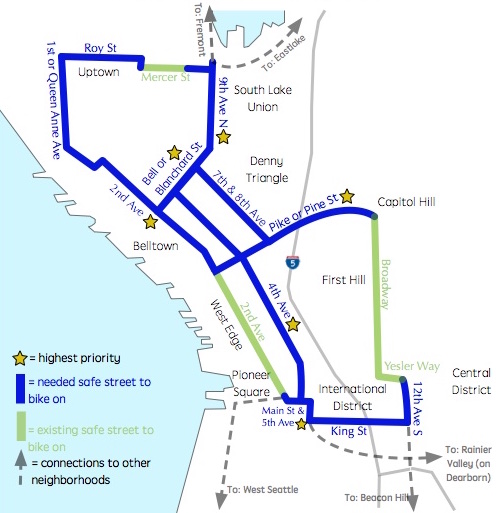
Now that affected corridors have been properly identified and Mayor Ed Murray has committed to bike lanes on 4th Ave, the city should work hard to make up for the last year of lost time building the downtown bike network. And that’s exactly what Cascade Bicycle Club and Seattle Neighborhood Greenways have proposed in a joint plan they are calling the “Basic Bike Network.”
Rather than slowly building fully-constructed bike lanes little-piece-by-little-piece, the city should move ahead quickly with a connected network of bike lanes using low-cost materials and methods in order to prioritize connectivity. Each new connection makes all the other bike lanes that much more useful, so let’s connect them all at once and see how it works.
The Basic Bike Network idea can also inform the One Center City plan. The city’s on-the-ground experiences with the lanes now could help guide the permanent street designs that come from the plan.
Cascade’s Kelsey Mesher presented the basic bike network plan to the One Center City advisory group Thursday evening. This could be an early win for the group and for the One Center City effort as a whole.
And most importantly, the city can immediately start reducing the number of people injured and killed every year on downtown streets:
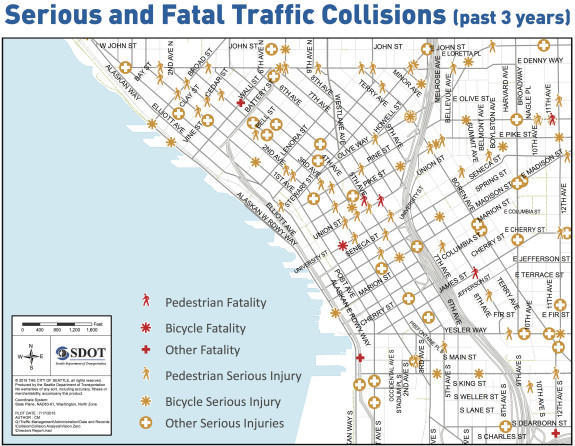

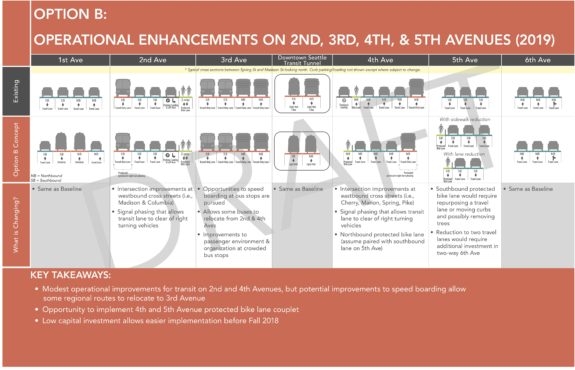
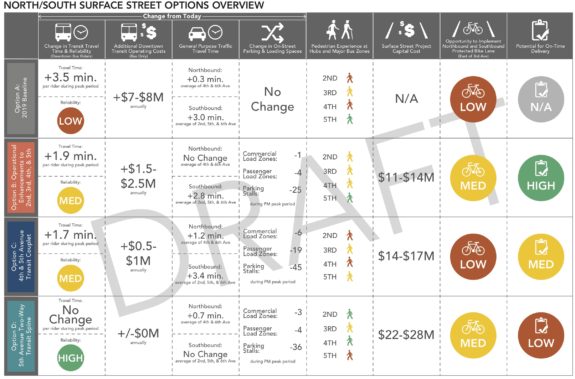







Comments
22 responses to “The One Center City plan includes some bold ideas, but fails to prioritize safety”
I ride 4th, 5th and/or 2nd Ave almost every day, coming up from the Southend. My 2 centavos:
I don’t have a preference between Option B (one-way protected bike lanes on both 4th and 5th) and D (two-way on 4th). Both are both acceptable.
My fear is that the lanes won’t extend far enough south. Currently, there is no safe or direct way to get from Dearborn Ave or SODO Bikeway to the bike lanes on 4th and 2nd.
That’s a major point. The Basic Bike Network map suggests bike lanes on Main and 5th to connect (that should go to Dearborn). It’s going to take a lot of advocacy to make sure that happens.
Admittedly, I feel like the bar for safe bike infrastructure is so low in this country that any protected bike lane, no matter how flawed, is a huge improvement. Having said that, it seems like the overall consensus among the bike community has been that 2 way protected bike lanes on streets with many turns is not the safest option. Meaning that it’s a good idea where we have it on Westlake but not on 2nd Ave and Broadway. Has anyone mentioned having one-way PBLs on separate streets?
Many people have, but folks who are more concerned with the perception of safety than actually advocating for safe infrastructure have largely ignored it. Anyone advocating for two-way PBLs, especially on otherwise one-way streets, has their priorities out of whack.
I’m not so sure about that. First, our downtown avenues are at very different elevations — that’s the whole reason 2nd doesn’t solve our north-south access problems once and for all. Second, my experience riding contraflow on 2nd downtown is that, sure, sometimes drivers don’t obey the signals and try to turn across my green, but I always see them well in advance. The same thing is true going with traffic, and those feel more dicey, because they start toward the edges of my field of view… and because I’m going faster. Not that I’m exactly flying downhill in the ‘track on 2nd, but there’s no question I’m going slower uphill.
This suggests that there’s more nuance than “two-way PBLs are bad”. I’d probably agree with you that Linden is bad, with its multitude of unprotected left turns and driveway crossings. Broadway has similar issues. A lot of BGT intersections work just like two-way cycletrack intersections (e.g. along Pacific in Wallingford) and I don’t trust them one bit. From a driver’s perspective, these are just difficult left-turns to make, as you have to wait for gaps in oncoming general-purpose traffic in one place at one speed, then additionally oncoming and overtaking bikes and pedestrians at a variety of speeds — it’s not that surprising that drivers perform poorly at them. On the downtown one-ways drivers don’t have to make turns across oncoming car traffic. All turns across the ‘track except driveways are signal-controlled, and the driveway turns are relatively easy (only crossing the cycletrack and sidewalk, sharp enough to require slowing to a near stop). I would still worry about drivers not seeing contraflow cyclists as they exit driveways… particularly fast-moving contraflow cyclists. This suggests that two-way PBLs are great on streets like 2nd: streets that are one-way downhill for cars, with all-signalized intersections and not a ton of driveways. And that they might have more problems on 4th, where contraflow bikes would be coming downhill… but that, without the problem of unprotected lefts, 4th might still be safer than a lot of other routes.
I’d be interested to see whether the data on 2nd matches my perception of it.
Al, I agree that two-way PBLs are fine, esp. citing your example about being able to see drivers making illegal turns as you bike toward them. This applies to the downtown bike network… certainly areas with more uncontrolled or stop-controlled intersections have more issues.
I actually prefer two-way PBLs to one-way PBLs by a wide margin. One-way PBLs are often built with “mixing zones” where cars cross the bike lane before making a right turn. Mixing cars at high speeds with bikes at lower speeds always feels much more dangerous than riding a two-way PBLs. Granted, I don’t have collisions stats, but I do know that rider comfort and perception of safety is how people decide whether or not to ride a bike.
There are lots of ways to make safe 2-way PBLs. I don’t think it’s correct to assume they are always more dangerous than a 1-way PBL. Individual lanes can have design flaws regardless of whether they are 1-way or 2.
I prefer 2 way PBLs too BUT I have read that they are not always the best practice. I am mostly referring to a Copenhagen bike blog that writes about how cities keep making the mistake of putting 2 way PBLs on streets with many crossings through the lane. In Copenhagen, they apparently only use these when they border parks and/or have limited or no crossings. It never would have even crossed my mind that a 2 way PBL is not a best practice. I just want to make sure we don’t end up paying for something we decide to change later.
FFS reduce the access for cars downtown. We have all kinds of examples from Copenhagen, Amsterdam, Tokyo, Paris (soon) et al, that we need transit and room for walkers and bikers in high density central cities.
And don’t get me started on all the underground parking approved for developments in SLU. Or the insane width of roadway when the viaduct comes down. Or the lack of bike lanes surrounding the new convention center expansion. We should be ashamed of not reaching for the utmost pro bike, walk and transit design possible downtown. Politicians can take the initial heat and will be thanked in the decades to come.
Build PBL’s and wider sidewalks nearly everywhere downtown and do it now. We can fit transit in too. But some cars will be slowed down, BFD, planet and our health demands walking and biking and bus and rail downtown. (Yeah in many neighborhoods too).
I think you’re too easy on this plan. After Move Seattle was approved, as well as Vision Zero, any document paid for with our tax dollars that reduces, not increases, bike lanes downtown should have been scrapped and the consultants on it told they weren’t going to be paid for their work on it.
Despite of the new ideas included in the planning, safety must be their first priority in the place. We know that there are still big changes in our road in the coming years especially in dealing traffic issues. I hope everything will work out fine regarding the plan.
Great post. We need to work together to keep downtown traffic moving safely. Seems like one way pbls should be our achievable goal.
Also fix the missing link.
Remember, the downtown bike network was approved through the Bike Master Plan (BMP) and funded through the Move Seattle Levy. Then the WSCC pushed ahead with its expansion plan hoping that no one will notice that attendance is lower than it was 20 years ago, and buses got forced out of the tunnel ahead of schedule causing SDOT to freak out.
City residents are getting something there is no need for (convention center expansion) while indefinitely delaying many things it has approved, has funded and desperately needs (downtown street safety improvements). It’s time to demand that city council stands up and rejects the WSCC’s street and alley vacation requests. The WSCC has no interest in what this city needs.
The Basic Bike Network is exactly the concept Seattle needs right now. Kudos to Cascade and SNG.
Comment sent.
I cant believe this was so important we had to wait for bike lanes to be built. It doesn’t even address cyclists as part of the study. We are an opportunity for them.
I have been only here two years but, want to tear my hair out.
My first commute dumped me at pike.
My second commute dumped into a parking lot till they could figure the lawsuit out.
My utility commute has me going over the Ballard and the missing link.
Big yawn. Another pinch of catnip for the cycling lobby so Murray and SDOT can mark time for another six months while they pretend like something great is about to happen any minute now. Murray is a political hack who cares about little besides reelection, and has clearly made the calculation that the best way to win another term is to pass around a new shiny map once or twice a year to keep us entertained, while in reality he does next to nothing to actually improve cycling conditions in the city. The bike community needs to get real about politics in this city or get used to Seattle streets the way they are.
Murray didn’t really have us the first time around (bikey people were just about the last to jump off the McGinn bandwagon, and some are still on it), and if he’s really going for our support this year he’s going about it in a funny way. He did his best and boldest bike stuff early in his term, and has been disappointing us since.
The reality about politics is that the bike community is too small to have much electoral power. We’ve been more effective at influencing existing leaders than getting leaders we like elected — McGinn rode a wider wave of anti-establishment sentiment related to viaduct replacement, but this isn’t a just Seattle thing, it applies in lots of cities. Bike-friendly ideas are a lot more popular in planning than on the ground — it’s like we’ve become part of the establishment without actually getting much of what we want. A lot of anti-bike people campaigned for Murray in 2013, and they’ll be against him this time… while the bike community will probably have a hard time finding a better candidate that has a serious chance. The convention center expansion really is going to affect a lot of people negatively, and Murray is the sort of politician that should be vulnerable to anger over that, but if anything the resentment would be primarily anti-bus-lane/pro-car-lane, and certainly wouldn’t usher in a leader with chain grease on his leg.
“Improving safety downtown is more important than car travel times.”
Hear, Hear!
I’m not a fan of two-way cycletracks. I prefer to ride with traffic when going downhill because it is easy to match their speed You cannot safely go nearly as fast on a 2-way PBL because you can’t count on drivers to signal their turns or even respect traffic signals and you’re too close to the sidewalk where a pedestrian might step out (especially if you are contra-flow and they aren’t expecting you from that side.) The problem is that even if you anticipate an issue you have nowhere to go when confined within a narrow bike lane. Of course I can and do ride in the general purpose lanes but tired of getting screamed at by drivers who think I’m somehow required to be in a bike lane if it exists.
Like Travis, I ride in from the south via 4th/5th every day. Any plan that does not address the clusterf&*# at Jackson (and apparently Dearborn, not on my route) is incomplete. The last two blocks heading west on Jackson and the first two on 4th before the bike lane begins are definitely the worst parts of my commute.
I wonder if a 2-way cycletrack in the center of a 2-way transit-only street could be feasible? Eliminates right hooks and oncoming left turners wouldn’t need to remember to look way over to see a cyclist, you’re right in front of them where they expect to look for oncoming traffic.
[…] Bike Network plan proposed by the Cascade Bicycle Club and Seattle Neighborhood Greenways, and championed by Seattle Bike Blog. We must build out a safe bike network as soon as possible. Advocates waited […]
I’m not a fan of 2-way PBLs for all of the reasons already given above. At the same time, it seems to me that skinny 1-way PBLs are ok only as long as you don’t need to pass a slower rider. In other words, 1-way PBLs succeed as infrastructure only as long as they fail to deliver on their promise of attracting more riders. All PBLs need special maintenance to be cleared of debris, which may or may not be done consistently. Since the “protection” offered by a line of shabby and broken plastic posts is illusory, maybe we should avoid all of these problems and stick to painted, 1-way bike lanes.
[…] Bike stakeholders not happy with One Center City planning. […]
My basic thinking about downtown Seattle travel starts with better transit. There’s a need to get motorists off the road, parked, and finish trips via transit. I favor parking garages for that reason among plenty others including Fare credits from parking garage charges and visa versa, parking credits for taking transit. But above all, transit has to be convenient, no longer than a 5-minute wait time. I don’t know Seattle’s bicycling patterns well enough to say which routes are ideal nor which can be most readily implemented. Travel downtown would be more commodious with less traffic. The Seattle Circulator Plan had these goals as its impetus. I still believe the basic design is possible. The 1st/3rd Trolleybus Circulator and for east/west transit routes, the Trolleybus Reconfiguration, probably just made too much sense and threatened Seattle’s car-dominated power brokers who run city hall. These city hall clowns are getting so good at deception, they’ve got environmentally conscientious believing self-driving cars is the wave of the future instead of obviously idiotic.